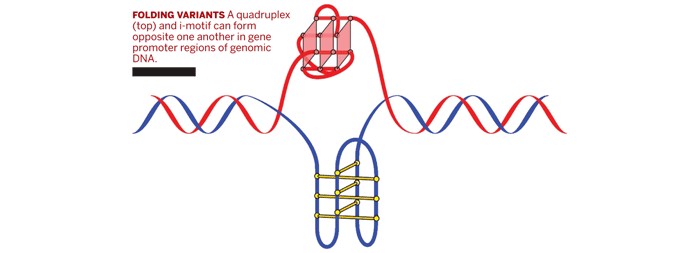Advertisement
Grab your lab coat. Let's get started
Welcome!
Welcome!
Create an account below to get 6 C&EN articles per month, receive newsletters and more - all free.
It seems this is your first time logging in online. Please enter the following information to continue.
As an ACS member you automatically get access to this site. All we need is few more details to create your reading experience.
Not you? Sign in with a different account.
Not you? Sign in with a different account.
ERROR 1
ERROR 1
ERROR 2
ERROR 2
ERROR 2
ERROR 2
ERROR 2
Password and Confirm password must match.
If you have an ACS member number, please enter it here so we can link this account to your membership. (optional)
ERROR 2
ACS values your privacy. By submitting your information, you are gaining access to C&EN and subscribing to our weekly newsletter. We use the information you provide to make your reading experience better, and we will never sell your data to third party members.
Genomics
DNA i-motifs found in human cells
Similar to G-quadruplexes, these folded DNA structures could be selective drug targets
by Stu Borman
April 26, 2018
| A version of this story appeared in
Volume 96, Issue 18

As if twisting itself into double helices isn’t hard enough, DNA also can fold into structures such as G-quadruplexes and i-motifs, which interrupt normal DNA base pairing. Researchers identified both forms of folded DNA in solution-based experiments and showed that they regulate gene transcription, making them potential cancer drug targets. But many questioned whether the folded structures actually existed in the human genome.
In 2013, a research group confirmed that G-quadruplexes were present in human cells (Nat. Chem. 2013, DOI: 10.1038/nchem.1548 and C&EN, Jan. 21, 2013, page 8). Now a separate group, led by Marcel E. Dinger and Daniel Christ of the Garvan Institute of Medical Research, has confirmed that i-motifs are also there (Nat. Chem. 2018, DOI: 10.1038/s41557-018-0046-3). The work helps pave the way for the search for i-motif-targeted drugs.
G-quadruplexes form when sets of guanine residues hydrogen bond to form flat structures called tetrads that stack into four-stranded DNA motifs. A molecule called quarfloxin (CX-3543) that targeted G-quadruplexes failed to show efficacy in clinical trials for different cancers. A related G-quadruplex-targeted agent, CX-5461, is now in trials for breast cancer.
I-motifs form when sets of cytosines pair with protonated cytosines, connecting U-shaped DNA strands. Because cytosines are normally protonated under acidic conditions that aren’t present in nuclei, researchers doubted that i-motifs existed in human cells. Previous studies included findings that small molecules targeting i-motifs could repress or activate gene expression in human cells (C&EN, March 24, 2014, page 7). But researchers didn’t believe these studies proved the presence of i-motifs in the human genome.
The Australian group used fluorescent-dye-labeled antibody fragments that bind i-motifs with high selectivity and affinity to detect the structures in human cells. The i-motifs were present in gene promoter regions and telomeres, suggesting that they regulate the genome.
“This is a very exciting discovery that will have an incredibly positive impact on the field,” says i-motif expert Zoë A. E. Waller of the University of East Anglia. “This work is the icing on what is now quite a large cake of evidence that these do exist in vivo. Hopefully, this will give people the evidence they need to believe these structures are worth working on.”




Join the conversation
Contact the reporter
Submit a Letter to the Editor for publication
Engage with us on Twitter